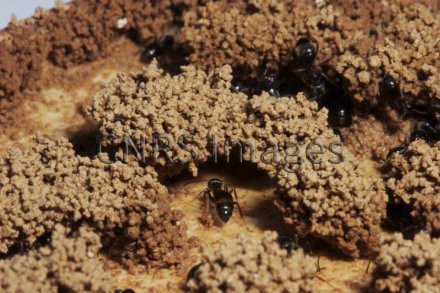Production year
2007

© Guy THERAULAZ/CRCA/CNRS Images
20170018_0005
Worker ants, Lasius niger, in their nest built in experimental conditions. By putting ants into experimental devices, research scientists are studying the formation of an antheap. After building pillars, the ants make deposits at height, as here in the photo. These globular structures form capitals which, joined together, create a vaulted passage. This study made it possible to determine that it is the ants’ deposition of pheromones onto the earth pellets that governs the entire dynamics of construction, growth and the shape of the nests. Antheaps exhibit an extremely complex and dynamic architecture. In fact, ants are constantly destroying the structures that they build and adapt their habitat to their environment, in particular the external meteorological conditions. Therefore, research scientists are trying to understand how these insects, guided by their collective intelligence, manage to build very elaborate structures while exhibiting simple individual behaviour.
The use of media visible on the CNRS Images Platform can be granted on request. Any reproduction or representation is forbidden without prior authorization from CNRS Images (except for resources under Creative Commons license).
No modification of an image may be made without the prior consent of CNRS Images.
No use of an image for advertising purposes or distribution to a third party may be made without the prior agreement of CNRS Images.
For more information, please consult our general conditions
2007
Our work is guided by the way scientists question the world around them and we translate their research into images to help people to understand the world better and to awaken their curiosity and wonderment.